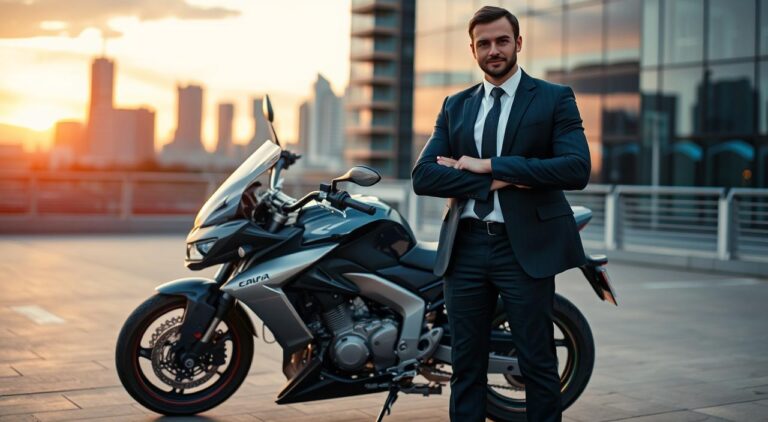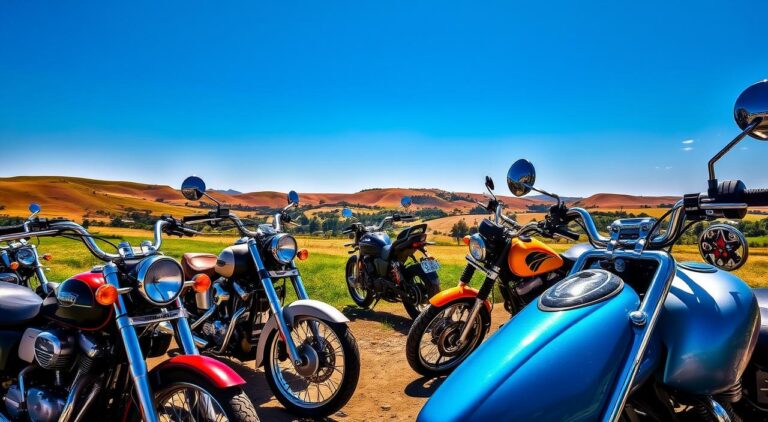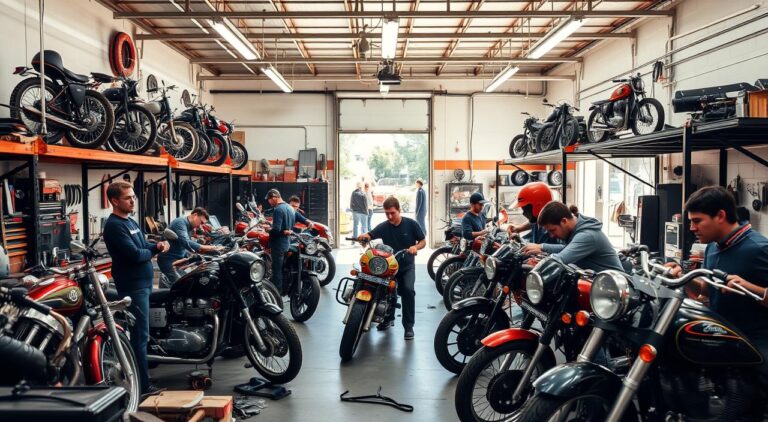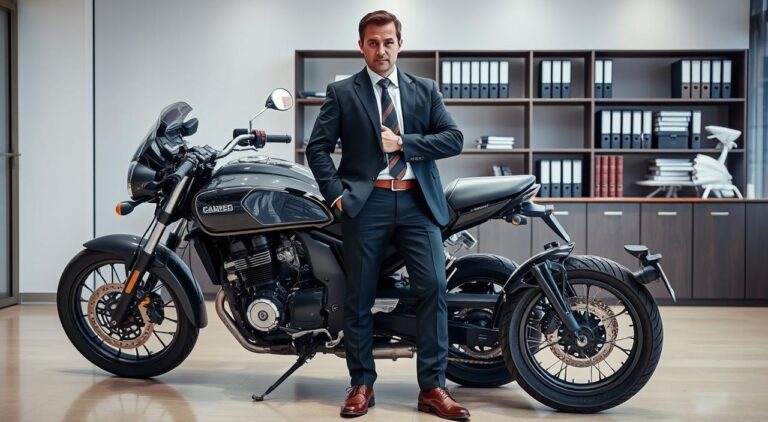Table of Contents
Remember the exhilaration you felt the first time you rode a motorcycle? The world seemed to rush past, the wind embraced you, and the road stretched endlessly ahead. Yet, amid this thrilling adventure, ensuring your safety should be paramount. As a motorcycle enthusiast, it’s easy to be captivated by performance and style, but understanding how to choose a safe motorcycle can make all the difference for your long-term riding enjoyment.
Choosing the right motorcycle involves more than just horsepower and aesthetics; it’s about prioritizing the motorcycle safety features that protect you during your rides. This guide delves into the essential aspects of identifying the safest motorcycles, highlighting brands that lead in safety innovations, and discussing the crucial technologies that can safeguard your journeys.
Key Takeaways
- Safety should be a top priority when selecting a motorcycle.
- Understanding motorcycle safety features can significantly enhance your riding experience.
- Brands like Honda, BMW, and Harley-Davidson are renowned for their commitment to safety.
- The right safety features can reduce the risk of accidents and injuries.
- Investing in a safe motorcycle ensures a longer, safer riding experience.
Understanding Motorcycle Safety Ratings
Motorcycle safety ratings provide invaluable guidance for riders looking to make informed decisions when purchasing a bike. These ratings assess various aspects of motorcycle safety, helping you understand how well different models protect you in case of an accident. By knowing the safest motorcycle accessories and the key components that contribute to safety, you can enhance your riding experience significantly.
The Importance of Safety Ratings
Safety ratings play a crucial role in ensuring that motorcyclists choose motorcycles that offer adequate protection. These ratings guide riders on bikes that meet or exceed established safe motorcycle criteria, ultimately reducing the risk of severe injuries. Understanding these ratings can help you prioritize safety features over aesthetic or performance attributes.
How Ratings are Determined
Motorcycle safety ratings are determined through comprehensive testing. Various factors are considered, including crashworthiness, advanced safety systems, and the effectiveness of the safest motorcycle accessories available with the bike. Independent testing agencies, such as the Insurance Institute for Highway Safety (IIHS), use controlled environments to simulate real-world crash scenarios, providing valuable insights into the bike’s safety performance.
Key Safety Features to Look For
When evaluating motorcycles, certain safety features are essential.
- Anti-lock Braking Systems (ABS): ABS helps prevent wheel lock-up, allowing you to maintain control during emergency braking.
- Traction Control Systems (TCS): TCS assists in maintaining grip on the road, particularly in slippery conditions.
- Stability Control Features: These features help keep the motorcycle stable, especially during cornering.
By understanding how these features contribute to higher motorcycle safety ratings, you can make a more informed decision about your next bike.
Recommended Brands for Safe Motorcycles
When considering the safest motorcycle gear and overall vehicle safety, certain brands stand out for their commitment to rider protection. Leading the pack are Honda, BMW, and Harley-Davidson, each renowned for their unique safety features and technologies.
Honda’s Safety Innovations
Honda has long been a leader among the top safe motorcycle brands, thanks to their advanced safety systems. Their motorcycles often come equipped with cutting-edge features such as anti-lock braking systems (ABS), traction control, and even airbag technology on certain models. Honda’s dedication to integrating smart safety solutions ensures they consistently produce some of the safest motorcycles on the market.
BMW’s Advanced Safety Technology
BMW motorcycles are synonymous with innovation and safety. The brand focuses heavily on incorporating advanced safety technologies, making them a popular choice for those seeking the safest motorcycle experience. From dynamic traction control to intelligent emergency call systems, BMW’s attention to detail helps prevent accidents and protect riders in case of emergencies.
Harley-Davidson’s Reliable Design
Harley-Davidson is celebrated for its robust and reliable motorcycle designs. Known among the top safe motorcycle brands, Harley-Davidson incorporates features like the reflex defensive rider system (RDRS) which enhances control and safety. Their commitment to building durable and safe motorcycles makes them a trusted name for those prioritizing safety on the road.
Essential Safety Features in a Motorcycle
Modern motorcycle safety features have come a long way, enhancing rider protection and control on the road. Among the most critical components to consider are Anti-lock Braking Systems (ABS), Traction Control Systems (TCS), and advanced stability control features. These elements work in tandem to ensure your journey is as safe as possible.
Anti-lock Braking Systems (ABS)
ABS on motorcycles is a game-changer in terms of safety. This system prevents the wheels from locking up during emergency braking, helping you maintain control and avoid skidding. With ABS, your braking distance is significantly reduced, particularly in slippery conditions, making it an indispensable feature for any rider prioritizing safety.
Traction Control Systems (TCS)
Another pivotal component of motorcycle safety features is the Traction Control System. TCS helps maintain your bike’s grip on the road by automatically adjusting the engine power based on wheel slip. This system is especially beneficial in wet or uneven terrains where traction is compromised, thereby ensuring a smoother and safer ride.
Stability Control Features
Motorcycle stability control is an advanced safety technology designed to keep your motorcycle balanced and stable, even under challenging riding conditions. This feature continuously monitors various parameters like wheel speed, lean angle, and acceleration to make real-time adjustments, providing you with enhanced control and confidence on the road.
The Role of Helmets in Motorcycle Safety
Undoubtedly, helmets are the most vital piece of safety equipment for motorcyclists. Their ability to protect riders from severe head injuries is unparalleled. By wearing the safest motorcycle helmets, you significantly reduce the risk of life-threatening injuries.
Importance of Wearing a Helmet
Wearing a helmet can mean the difference between life and death in the event of an accident. Helmets are designed to absorb impact and protect your head from trauma. Thus, it is essential to always wear a helmet every time you ride.
Choosing the Right Helmet
When it comes to choosing the right helmet, several factors need consideration. The fit, style, and type of helmet determine its effectiveness. Ensure that the helmet fits snugly but not too tight, providing comfort for long rides. Equally important is selecting a style that suits your riding preferences, whether a full-face, modular, or half-shell helmet.
Helmet Safety Certifications
Helmet safety certifications are crucial as they signify the helmet has passed stringent testing standards. The most recognized certifications are DOT (Department of Transportation), ECE (Economic Commission for Europe), and Snell. These certifications guarantee that the helmet provides adequate protection and has met rigorous safety criteria. When selecting a helmet, always look for these certifications to ensure you are investing in the safest motorcycle helmets available.
Safety Gear to Complement Your Motorcycle
Alongside the motorcycle itself, using the safest motorcycle accessories can significantly enhance your overall riding experience. Having the right gear ensures not only your comfort but also your safety during rides. Investing in top-quality protective riding gear is essential for every rider. This section delves into the various types of motorcycle safety apparel that every rider should consider.
The Benefits of Protective Clothing
Wearing protective clothing is crucial as it serves as a first line of defense in the event of an accident. High-quality jackets and pants, often made of durable materials like leather or Kevlar, can prevent severe injuries. Moreover, including gloves in your gear is highly recommended to shield your hands from abrasions and impacts. Comprehensive protective riding gear is designed to withstand the rigors of the road, providing essential coverage for vulnerable parts of the body.
Knee and Elbow Pads: Why They Matter
Knee and elbow pads are critical components of any rider’s attire. These pads offer targeted protection to joints, which are particularly susceptible to injuries during a fall or collision. By incorporating these safest motorcycle accessories into your gear, you can significantly reduce the risk of fractures and other serious injuries. Quality knee and elbow pads are typically made with strong yet flexible materials, ensuring both safety and comfort during rides.
Investing in Quality Footwear
Choosing the right footwear is another vital aspect of motorcycle safety. Sturdy boots designed specifically for riding offer enhanced protection for your feet and ankles. These motorcycle safety apparel items often come with reinforced toes and heels, providing extra durability and shielding against impacts. Ensuring you wear appropriate riding footwear can make a significant difference in maintaining balance and control during your rides.
Riding Techniques for Enhanced Safety
Mastering effective riding techniques is crucial for ensuring motorcycle riding safety. By employing defensive riding techniques and the safest motorcycle riding tips, you can significantly reduce the risk of accidents and enjoy a safer riding experience.
The Importance of Defensive Riding
Defensive riding is a skill that every motorcyclist should hone. It involves being constantly aware of your surroundings and anticipating potential hazards before they become imminent threats. Advanced defensive riding techniques include maintaining a safe distance from other vehicles, being predictable in your movements, and always having an escape route in mind. These strategies collectively contribute to motorcycle riding safety and can help prevent accidents.
Tips for Navigating Different Road Conditions
Road conditions can vary greatly and knowing how to adjust your riding style is essential. For wet surfaces, reduce your speed and avoid abrupt movements to prevent skidding. On uneven or gravel roads, keep a steady throttle and avoid heavy braking to maintain control. Adapting to these conditions with the safest motorcycle riding tips ensures a smoother ride and reduces the risk of losing control.
How to Handle an Emergency Situation
In emergency scenarios, your response time and actions are critical. Practice quick decision-making skills, such as swerving or emergency braking, in controlled environments to prepare for real-life situations. Always stay calm and remember that the key to motorcycle riding safety in emergencies is having a well-practiced plan and the ability to execute it under pressure.
Statistics on Motorcycle Accidents and Safety
Understanding recent motorcycle accident statistics and the underlying factors is crucial for enhancing rider safety. By delving into current data and comprehensive motorcycle safety research, you can better grasp the preventive measures necessary to mitigate risks.
National Trends in Motorcycle Accidents
Nationwide, analyses of motorcycle accident statistics reveal a concerning trend. Over the past decade, motorcycle-related fatalities have consistently accounted for a significant portion of total traffic deaths. Although advancements in safety protocols and technology have begun to curtail these numbers, motorcyclists still face heightened risks compared to other road users.
Factors Contributing to Accidents
Various elements contribute to the prevalence of motorcycle accidents. Key factors identified by motorcycle safety research include human error (such as speeding and impaired driving), adverse weather conditions, and lack of proper safety gear. Additionally, the smaller size and less visible nature of motorcycles often lead to accidents caused by other drivers failing to notice motorcyclists on the road.
How Safety Measures Reduce Risks
Implementing effective risk reduction strategies can significantly enhance rider safety. Benefits derived from comprehensive motorcycle safety research underscore the efficacy of Anti-lock Braking Systems (ABS), proper helmet use, and advanced rider training programs. These measures collectively contribute to a reduction in accident rates and fatalities, fostering a safer riding environment for everyone.
The Future of Motorcycle Safety Technology
Technological advancements continue to modify the framework of motorcycle safety, giving riders a much-needed assurance on the road. As we look forward to the wealth of innovations shaping the future motorcycle safety, let’s explore the groundbreaking developments expected to redefine the safest motorcycle technology.
Innovations on the Horizon
Emerging advancements are set to transform the landscape of motorcycle safety. Technologies like vehicle-to-everything (V2X) communication and enhanced rider assistance systems are on the rise. These allow motorcycles to communicate with other vehicles and infrastructure, significantly reducing the risk of accidents.
Smart Helmets and Connectivity
Smart motorcycle helmets are revolutionizing the way riders experience the road. Equipped with heads-up displays, GPS navigation, and Bluetooth connectivity, smart helmets present real-time data directly in the rider’s line of sight. This not only enhances convenience but also substantially improves safety by minimizing the need for riders to take their eyes off the road.
Automated Safety Features
Automated features such as adaptive cruise control, automatic emergency braking, and lane-keeping assist are being integrated into the latest models, offering a glimpse at the safest motorcycle technology of tomorrow. These systems closely monitor driving conditions and make split-second decisions, thus preventing potential collisions and enhancing rider safety.
The integration of these technological advancements signifies a promising shift towards a safer riding experience. As the industry steadily embraces these changes, riders can look forward to a future where future motorcycle safety is prioritized like never before.
Cost Considerations for Safe Motorcycles
Understanding the cost of safe motorcycles is crucial for making a wise investment. While the initial price tag of safety-enhanced models can be higher, the long-term savings and benefits often outweigh the upfront costs. Here are some key considerations when evaluating the expenses associated with safe motorcycles.
Comparing Prices of Safety-Enhanced Models
When comparing the prices of safety-enhanced models, it’s important to consider features such as Anti-lock Braking Systems (ABS), traction control, and advanced stability controls. These features may add to the initial cost but provide significant benefits in accident prevention and overall riding safety.
Long-term Savings with Safety Investments
Investing in safety does more than protect you on the road; it also offers a notable safety investment return. Reduced risk of accidents means fewer repair costs and medical expenses, contributing to long-term financial savings. In addition, safer motorcycles often have better durability and longevity, reducing the need for frequent replacements.
Insurance Benefits for Safe Motorcycles
One of the major advantages of opting for safe motorcycles is the insurance benefits. Models recognized for their safety records often come with lower insurance premiums. Insurance companies assess the risk of accidents and injuries, and safer bikes usually translate to more affordable rates, adding to the overall cost savings.
Community and Resources for Safe Riding
The motorcycle community offers a wealth of resources to help you enhance your safety knowledge and skills. By tapping into these, you can ensure a safer and more enjoyable riding experience.
Organizations Promoting Motorcycle Safety
Various organizations are dedicated to promoting motorcycle safety. Groups such as the American Motorcyclist Association (AMA) and the Motorcycle Safety Foundation (MSF) provide valuable insights and safety protocols. These motorcycle safety communities advocate for rider education, policy development, and community engagement to keep you well-informed and prepared for the road.
Training Courses and Workshops
Enrolling in rider training courses can significantly improve your riding skills and enhance your safety awareness. Institutions like MSF offer a variety of training sessions catered to different skill levels, from novice to advanced riders. These courses cover essential aspects of motorcycle safety, including defensive riding techniques and emergency response strategies. Attending workshops can also provide hands-on experience, helping you gain confidence in real-world scenarios.
Online Safety Forums and Groups
Engaging with online safety resources through forums and groups can connect you with fellow riders who share their insights and experiences. Websites and social media platforms host numerous motorcycle safety communities where you can discuss topics ranging from safety gear recommendations to riding techniques. Participating in these online forums not only broadens your knowledge but also enables you to stay updated on the latest safety tips and innovations.
Conclusion: Choosing the Safest Motorcycle for You
As you finalize your decision on making a safe motorcycle choice, it’s crucial to integrate all the critical aspects discussed in this guide. From evaluating comprehensive safety ratings to selecting a model equipped with state-of-the-art safety features, every detail contributes to your overall riding experience. Prioritizing motorcycle safety not only involves picking the right model but also includes investing in quality gear and adopting proper riding techniques.
Making an Informed Decision
When you approach the marketplace, ensure you are well-informed about the various safety ratings and what they signify. Detailed research into recommended brands like Honda, BMW, and Harley-Davidson can aid in identifying the models that have excelled in safety evaluations. Remember, making a safe motorcycle choice is about balancing your personal preferences with overarching safety performance data.
Prioritizing Safety in Your Purchase
Your investment will go beyond the upfront cost; consider the long-term benefits of opting for a motorcycle with advanced safety features. Enhanced braking systems, traction controls, and stability features significantly reduce your risk of accidents. Prioritizing motorcycle safety means looking beyond aesthetics and speed, and focusing on technologies that safeguard your rides under diverse conditions.
Embracing a Safe Riding Experience
Lastly, embracing riding safety entails a holistic approach. Equipping yourself with certified helmets and protective gear, undergoing training courses, and participating in safety communities are all integral parts of a safe riding culture. By integrating these elements, you’ll not only enhance your personal safety but also contribute to a broader community of responsible motorcyclists.
FAQ
How do I choose a safe motorcycle?
To choose a safe motorcycle, it’s important to consider various aspects such as the motorcycle’s safety features, the brand’s reputation for safety, and the model’s safety ratings. Look for key features like ABS, TCS, and stability control, and research the top safe motorcycle brands known for their commitment to rider protection.
Why are motorcycle safety ratings important?
Motorcycle safety ratings provide crucial information on how different models perform in crash tests and safety evaluations. These ratings help you make informed decisions by highlighting the safety performance of each motorcycle, ensuring you select the best option for your safety needs.
What are the key safety features to look for in a motorcycle?
Key safety features to look for include Anti-lock Braking Systems (ABS), Traction Control Systems (TCS), and stability control features. These technologies enhance safety by preventing wheel lock during emergency braking, maintaining grip, and keeping the motorcycle balanced.
What are some top safe motorcycle brands?
Some top safe motorcycle brands include Honda, BMW, and Harley-Davidson. These manufacturers are renowned for their commitment to integrating advanced safety technology and designing motorcycles with robust and reliable safety features.
How important is it to wear a helmet while riding?
Wearing a helmet is critically important for motorcycle safety. Helmets protect your head in case of an accident and can significantly reduce the risk of serious injury or death. Always choose helmets that meet safety certifications such as DOT, ECE, or Snell.
What protective gear should I wear while riding a motorcycle?
In addition to a helmet, you should wear protective clothing such as jackets, pants, gloves, and quality riding footwear. It’s also essential to use knee and elbow pads to protect joint areas in case of a fall or collision.
What are some defensive riding techniques for enhanced safety?
Defensive riding techniques include always being aware of your surroundings, anticipating other drivers’ actions, maintaining a safe distance, and avoiding blind spots. These strategies can greatly enhance your safety by preventing accidents and enabling you to react promptly to potential hazards.
How do motorcycle safety measures help reduce accident risks?
Safety measures such as wearing proper gear, using safety features like ABS and TCS, and adhering to safe riding techniques can significantly reduce the risks of accidents. Statistics show that well-informed riders who prioritize safety measures experience fewer and less severe accidents.
What future motorcycle safety technologies are being developed?
Future motorcycle safety technologies include innovations such as smart helmets with heads-up displays, connectivity features, and automated safety systems. These advancements are aimed at increasing rider awareness, improving crash prevention, and enhancing overall safety.
Are there financial benefits to choosing a safe motorcycle?
Yes, choosing a motorcycle with enhanced safety features can lead to long-term savings. Safer models often result in fewer accidents and lower repair costs. Additionally, insurance companies may offer lower premiums for motorcycles recognized for their safety records, further contributing to financial savings.
What resources are available for improving motorcycle safety knowledge?
Numerous resources are available, including organizations that promote motorcycle safety, training courses, and workshops. Online forums and groups also provide valuable information and allow you to connect with other riders who share experiences and safety tips.












